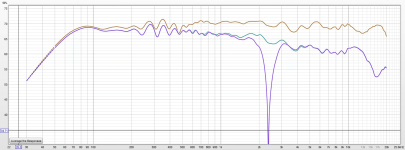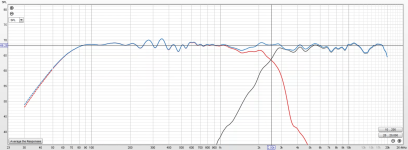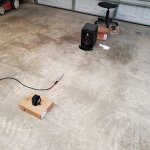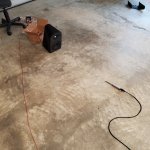Would be nice to do the distortion relatively (in dB or percentage).
Here you go. Both 100 dB SPL, equalized; left free air, right waveguide.
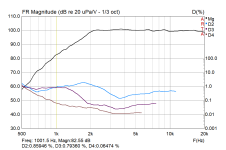
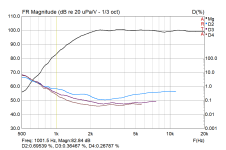
I should note that while SPL calibration was accurate, I used different measurement chain gain structure for either run. So higher harmonics might represent the noise floor of the signal chain, especially in the waveguide measurement. Getting those 100% representative is very challenging, especially with high end hardware like the Bliesmas with ultra low distortion figures... you can't have any bit of slightest noise introduced into the measurement from any of the multiple potential sources.
Well if it's fully masked by the noise floor anyway, I guess the numbers don't really matter anymore to begin withSo higher harmonics might represent the noise floor of the signal chain, especially in the waveguide measurement. Getting those 100% representative is very challenging, especially with high end hardware like the Bliesmas with ultra low distortion figures... you can't have any bit of slightest noise introduced into the measurement from any of the multiple potential sources.
Higher harmonics != all harmonics. K2 is definitely fully representative in all the graphs, and H3 almost as well. If you've once seen how electronics noise floor looks like in distortion measurements, as opposed to loudspeaker distortions, you'll also easily recognize it - it's basically a flat line of all harmonics mashed together. That's not what happens here.
Either way, well demonstrated that interpretation is just as important as the data and its documentation
Either way, well demonstrated that interpretation is just as important as the data and its documentation
I was being sarcastic about it lol. I thought that was obvious, haha
(well it holds a little bit of truth, but that is a different discussion)
But yeah, this is why showing the distortion in a relative way is so important, because you can actually see what is going on
(well it holds a little bit of truth, but that is a different discussion)
But yeah, this is why showing the distortion in a relative way is so important, because you can actually see what is going on
While these distortion curves are a huge help for designing a speaker ... it's a complete different discussion what this means for listening and perception.
At 100dBSpl our ear already does a lot of THD by itself. These drivers have so low THD - with a cheap/small measurement mic (these 1/4" ref mics have a LOT of noise) you will always run into the noise floor. I always do a noise floor measurement when measureing outside my lab room.
(I never could measure the noise floor in the listening/measurement room. The mic with the lowest noise floor I have is around 8dBSpl(A) and I can measure this noisefloor perfectly )
)
At 100dBSpl our ear already does a lot of THD by itself. These drivers have so low THD - with a cheap/small measurement mic (these 1/4" ref mics have a LOT of noise) you will always run into the noise floor. I always do a noise floor measurement when measureing outside my lab room.
(I never could measure the noise floor in the listening/measurement room. The mic with the lowest noise floor I have is around 8dBSpl(A) and I can measure this noisefloor perfectly
with a cheap/small measurement mic (these 1/4" ref mics have a LOT of noise) you will always run into the noise floor.
In my case it's (mostly) the pre-amp. It has an SNR of about 80, 90 dB. If I set the gain structure for the measurement to (almost - don't want to clip either) max out its dynamic range, the noise floor will be low enough relative to the actual signal to show accurate behavior for even higher harmonics. If I did that though, I'd have to switch gain on the pre-amp and then load an appropriate calibration file in ARTA for practically every measurement, and I'd never get any work done. So in practice I use two to three gain structures & calibration files for various levels, mostly just two (one for up to ~100 dB, one for up to ~125 dB), and that's good enough for most cases.
But yes, of course, the whole signal chain (& environment) is to some degree an influence. In the document I linked in my first post in this thread, ARTA Ringversuch, you can see my measurements of a Purifi midwoofer & SB26ADC vs. a Klippel NFS with G.R.A.S. microphone and electronics. While our frequency responses (frequency & SPL calibration) matched almost perfectly, it thoroughly outclassed me in the low level distortion measurements of these also very low distortion speakers. That's where the wheat separates from the chaff, and one knows why the other guy paid x times as much for his hardware.
Last edited:
If it's just about noise floor, you can average your measurements.
Although that only goes with a 10log.
So getting more than 12dB extra is getting very tedious. (that's 16 averages)
But I think you will run into environmental noise more quickly.
Which can be easily 30-40dB.
So an SNR of 60-70dB at best.
edit: Even something like a Audix TM-1 (and maybe a beyerdynamic MM1 ?) will be just fine in sense of SNR.
Well that is confusing, saying their dynamic range is 112dB but SNR is 66dB, so never mind lol
Anyway, I don't really see the purpose for designing a good performing loudspeaker to exactly know these numbers.
As long as you know where the problems are, that's all you need to know.
Although that only goes with a 10log.
So getting more than 12dB extra is getting very tedious. (that's 16 averages)
But I think you will run into environmental noise more quickly.
Which can be easily 30-40dB.
So an SNR of 60-70dB at best.
Well that is confusing, saying their dynamic range is 112dB but SNR is 66dB, so never mind lol
Anyway, I don't really see the purpose for designing a good performing loudspeaker to exactly know these numbers.
As long as you know where the problems are, that's all you need to know.
Last edited:
Quick comment on mic options: Earthworks with ultra high sensitivity that requires a level pad for high level measurements - no thanks. MM1's Max. SPL @ THD is lacking and would add significant extra distortion probably already @ 100, certainly at 105 dB; SNR isn't the only thing that counts.
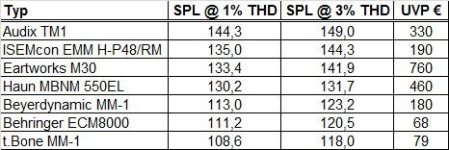
(source: Production Partner)
Environmental noise is not constant, and is something I definitely keep an eye on. If I see an artifact in the measurement because for example a bird tweets somewhere in the vicinity, I repeat the measurement during a quieter period. Note, you'll only have to find a ~1s quiet window.
That's also the problem with averaging - during one of the runs, environmental noise might introduce itself, and ruin the whole series of 4 or 8 or 12 or however many averages you choose.
Anechoic chamber / lab is preferrable for HF measurements - lower noise - but offers little to no advantage for LF measurements, because every an. chamber has a lower frequency at which wavelengths get too large for its damping elements to properly function. Bafflestep corrected NF measurements help around that, but aren't ideal for distortion measurements. That's why I've never been a fan of anechoic chambers.
For ultra clean free field far field measurements, I pack my measurement equipment into my car, which has a DC 12 -> AC 230V full sine converter, drive to a place far from civilisation, at night, on a wind free day. You'll still have to watch out for air travel, but apart from that, this is pretty much the ideal measurement environment in which you can measure the whole frequency range reflexion free and noise free. I just don't always choose to make that rather large effort.
Yep - exactly my rationale behind not going completely overboard with the measurement accuracies - everyone can see what's important, and that's enough.
Anyway. Getting slightly OT. If anyone has a further request specific to these waveguides, shoot. Best via PM (I get notified via mail), since I'm usually here very sporadically.

(source: Production Partner)
Environmental noise is not constant, and is something I definitely keep an eye on. If I see an artifact in the measurement because for example a bird tweets somewhere in the vicinity, I repeat the measurement during a quieter period. Note, you'll only have to find a ~1s quiet window.
That's also the problem with averaging - during one of the runs, environmental noise might introduce itself, and ruin the whole series of 4 or 8 or 12 or however many averages you choose.
Anechoic chamber / lab is preferrable for HF measurements - lower noise - but offers little to no advantage for LF measurements, because every an. chamber has a lower frequency at which wavelengths get too large for its damping elements to properly function. Bafflestep corrected NF measurements help around that, but aren't ideal for distortion measurements. That's why I've never been a fan of anechoic chambers.
For ultra clean free field far field measurements, I pack my measurement equipment into my car, which has a DC 12 -> AC 230V full sine converter, drive to a place far from civilisation, at night, on a wind free day. You'll still have to watch out for air travel, but apart from that, this is pretty much the ideal measurement environment in which you can measure the whole frequency range reflexion free and noise free. I just don't always choose to make that rather large effort.
Anyway, I don't really see the purpose for designing a good performing loudspeaker to exactly know these numbers.
As long as you know where the problems are, that's all you need to know.
Yep - exactly my rationale behind not going completely overboard with the measurement accuracies - everyone can see what's important, and that's enough.
Anyway. Getting slightly OT. If anyone has a further request specific to these waveguides, shoot. Best via PM (I get notified via mail), since I'm usually here very sporadically.
Last edited:
Well, you will be surprised, but actually it IS quite constant.Environmental noise is not constant, and is something I definitely keep an eye on. If I see an artifact in the measurement because for example a bird tweets somewhere in the vicinity, I repeat the measurement during a quieter period. Note, you'll only have to find a ~1s quiet window.
More or less. There is so much literature and books about this.
Just do the same measurements during the day or deep at night in the winter when there is no wind.
That will give you at least 15-25dB extra SNR
Depending where you live, but this noise is pretty broadband even.
The wonderful thing about averaging, is that the little bird will also average out.
Unless it's singing over the full measurement period.
But you can basically just randomly measure every so often and average those results.
With an anechoic room you can make your time window (much) bigger, which means higher frequency resolution.
The weird thing is that only a few people seem to do that.
Instead you still get measurements with horrible erratic peaks and dips in it.....
What is the purpose of getting such extremely results btw?
In my measurement room I normally don't use short gating - a 2s sweep and 1s gate. You get unregularities at lower frequencies but at least high resolution over all. VERY high resolution - so I normally do a 1/24 ocatve smoothing to dampen measurement artefacts. When you know the room you can get pretty good measurements you can rely on.
One of the nice things of my audio precision system - you don't need any preamp. The input can take very high voltages and has a self noise about 0,8uVrms(A). So fine for all these mesurement microphones. I usually use a M50 which is also fine for most nearfield measurements. For loud stuff you need to take a 1/4" ... you won't distort these with a loudspeaker
All small membrane microphones have higher noise (less capacity from the membrane area) and lower sensitivity -> pretty high self noise. Lower as 0,1% THD is not easy to measure ... but most speakers can't deliver that anyways ;-)
One of the nice things of my audio precision system - you don't need any preamp. The input can take very high voltages and has a self noise about 0,8uVrms(A). So fine for all these mesurement microphones. I usually use a M50 which is also fine for most nearfield measurements. For loud stuff you need to take a 1/4" ... you won't distort these with a loudspeaker
All small membrane microphones have higher noise (less capacity from the membrane area) and lower sensitivity -> pretty high self noise. Lower as 0,1% THD is not easy to measure ... but most speakers can't deliver that anyways ;-)
I think I've settled on the final(ish) design for the smaller two-part 3D printed enclosure with the integrated AP waveguide. This particular test shows the sealed design, but also have final(ish) designs for a ported box. I've done a preliminary run through with some spare x-over parts I had laying around.


Here's an un-gated distortion plot, pay no attention to the SPL, I have yet to calibrate it:

As well as the 60 degree off-axis and inverted plot, 20ms gating at 15 cycles:

It's been hot a heck in my garage so I haven't persuaded myself to do a complete suit of directivity measurements and the like. Also since I am still fine tuning the crossover.
I'm all open for comments if anyone has suggestions or advice regarding crossovers, measurement techniques, or anything else!
Here's an un-gated distortion plot, pay no attention to the SPL, I have yet to calibrate it:
As well as the 60 degree off-axis and inverted plot, 20ms gating at 15 cycles:
It's been hot a heck in my garage so I haven't persuaded myself to do a complete suit of directivity measurements and the like. Also since I am still fine tuning the crossover.
I'm all open for comments if anyone has suggestions or advice regarding crossovers, measurement techniques, or anything else!
Attachments
There is still quite a bit of interference in the measurements.I'm all open for comments if anyone has suggestions or advice regarding crossovers, measurement techniques, or anything else!
Probably coming from the garage door.
Keep in mind you need around 1 meter (about 3 feet) of free space around your speaker (seen from front baffle) as well as the microphone.
Having things anti-parallel to the walls can also help a bit.
I would suggest using a hybrid method with stitching, near-field as well as ground measurements!
Thanks! The speaker is tilted, you just can't see it very well in this pick.Really like your design ideas and how this comes together!
I would tilt the speaker more so you don't have an vertical angle?
@augerpro, Waiting for something on it!I keep forgetting to make a 4" for the T25B. It will be in the next round! Thanks for reminding me.
thank you.
Thank you for all the work Augerpro and the good discussion on this topic!
I have just ordered 2x5 inch sb26cdc waveguides.
I just got the quote out of curiosity but when I saw the price I ordered a pair haha! 27 USD in total for both, including shipping fee. I used the treatstock website mentioned earlier in the thread and they have local printers so as I am based in Stockholm Sweden I ordered from a local firm and the price really surprised me.
I ordered the noPS since I chose the cheapest manufacturer and wanted to avoid complicating things since I am new to this and don't really know how it works, however I do have a question regarding this. How much will the sb26cdc suffer without a phase shield? If I am content with the quality, should I go ahead and use the noPS version or is it worth an extra 27 USD to order a pair with phase shield?
The specs of the print is as follows, does this seem fine or or will the quality be lacking?
Was thinking something like this but probably with more bevels where there are sharp edges now. Maybe I could even get them to print the baffle as a shell and then maybe fill it with something? And then go ahead and include the waveguide in the baffle print? Will try to get a quote for the price of that aswell i think hehe.

I have just ordered 2x5 inch sb26cdc waveguides.
I just got the quote out of curiosity but when I saw the price I ordered a pair haha! 27 USD in total for both, including shipping fee. I used the treatstock website mentioned earlier in the thread and they have local printers so as I am based in Stockholm Sweden I ordered from a local firm and the price really surprised me.
I ordered the noPS since I chose the cheapest manufacturer and wanted to avoid complicating things since I am new to this and don't really know how it works, however I do have a question regarding this. How much will the sb26cdc suffer without a phase shield? If I am content with the quality, should I go ahead and use the noPS version or is it worth an extra 27 USD to order a pair with phase shield?
The specs of the print is as follows, does this seem fine or or will the quality be lacking?
| Quantity | 2 items |
| Layer Resolution | 100 micron (0.004 in.) - 300 micron (0.011 in.) |
| Infill | 20% (default) |
| Material & Color | PLA Black |
Was thinking something like this but probably with more bevels where there are sharp edges now. Maybe I could even get them to print the baffle as a shell and then maybe fill it with something? And then go ahead and include the waveguide in the baffle print? Will try to get a quote for the price of that aswell i think hehe.
- Home
- Loudspeakers
- Multi-Way
- Open source Waveguides for CNC & 3D printing!
